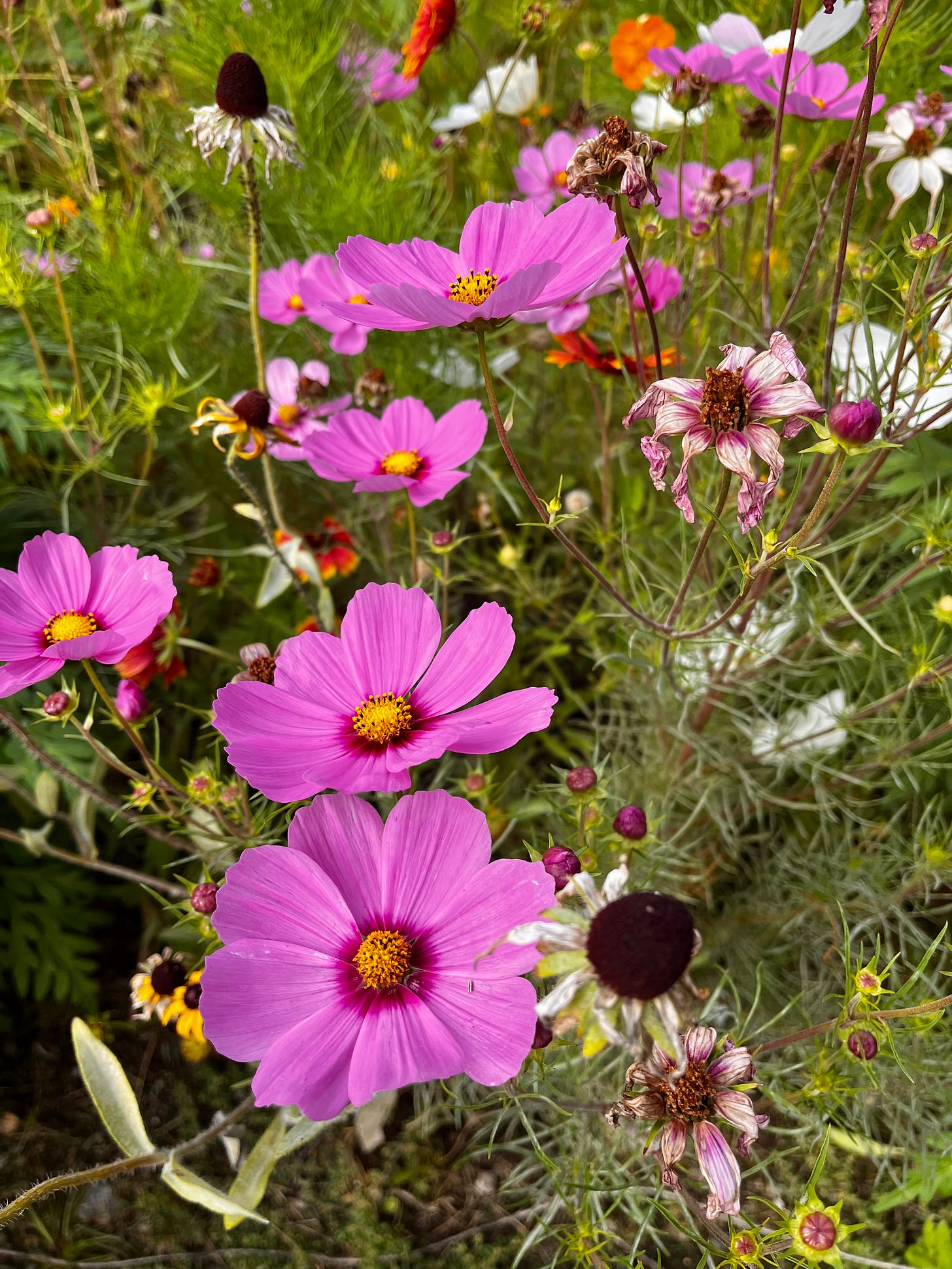Thanks for reading the Classical Roots Substack. If you enjoy what you’re reading here and want to support this writing project or our work in school agriculture, please consider subscribing—it’s free and easy.
Pretty often these days, when I run into students from our volunteer program, they tell me something to the effect of “Mr. Miller, we’ve got to do something about the orchard.” "What’s wrong with the orchard?” I ask, and the reply is always the same: “It looks too wild.”
My usual response to this assertion is to snap “Nonsense!” and walk the other way. But I had ten minutes to spare after the most recent incident, so I popped on a ballcap (Go Braves!) and took a walk along the mowed, wildflower-flanked paths that connect our various fledgling trees. It’s an exhilarating place to spend time at this peculiar, particular, romantic, harshening moment in the year: the gnarled, desiccated heads of Black-Eyed Susans jut above stalks already white with mildew, the lanky fireworks of asters are just beginning their slow-motion eruptions in purple, and the few alliums the wind hasn’t beheaded stand as erect and inscrutable as brutalist sculptures, their spheres of needling seedheads like still-shots of exploding flak. Everywhere, decay is mingled with the last, brutal exuberance of September. Oak and maple leaves flutter like hooked fish, snagged on the grassy seedheads, and the soldiers from our resident in-ground hornet’s nest strafe the orchard’s eastern edge like warpainted berserkers under suicidal orders.
Amidst all this plant life is the teeming evidence of animal life, as well: countless chocolate pebbles of rabbit scat in the short grass, the lilting flutes of goldfinches harvesting seed, the desperate scatter and scrabble of field mice through the undergrowth. For me, this kaleidoscopic, fetid concurrence is clear evidence that the orchard is doing one of the things we want it to do: namely, playing host to a functional ecosystem. But aesthetic considerations have their place as well. So I asked myself, does it look too wild? What would that even mean?
By definition, a garden is a tended space. Though the English tend to call any backyard “the garden,” everyone knows that this label sours into a misnomer if you let your little swath of green go to seed. No one would walk into the pristine expanse of Glacier National Park, turn to their backpacked companions, and say “Nice garden!” We have different ideas in mind when we use that term. But those ideas need not be limited to the trim, classical elegance of an Italian power-garden or the restrained decorum of a brick wall lined with espaliered pears. Indeed, the term “wild garden” has grown in popularity lately, as the water cost of grass lawns, not to mention their horrific ecological impact, has made alternate household landscapes more broadly appealing.
So, is that what our orchard is: a wild garden? Yes and no. Inevitably, it will come to look more measured and refined as the young trees grow. Right now, the late-summer wildflowers tend to rise almost level with the tops of our apples and plums, lending the space an air of rakish pugnacity—everything bold and wild and happening at once. But as the trees mature, their clean, even rows will create a visual structure to ground and balance the akimbo flowers and meandering paths. In fact, the whole design of that space was an exercise in contrasts, since it’s always pleasing to see curved lines contrasted with straight ones. In time, the twenty-seven stately shadows of the orchard trees, arranged as neatly as mustered soldiers, will make the whole place seem far less wild, even if we do nothing at all to manage what grows below.
But of course, we won’t be so negligent. In fact, only last week, we made considerable visual improvements to the orchard by simply removing the tall dandelions that were swaying there like ragged masts. Though you couldn’t have picked out any offending individual as you drove by the space on a cool morning, removing all of them has restored a general sense of order. Indeed, if a universal principle can be extracted from the whole exercise it’s that, whatever you do with your garden, you should make it look like it was on purpose.
What makes a garden a garden? The rumor of human hands. Though we tend to think of them only as natural things, there’s nothing natural at all about gardens. More accurately, they’re minglings of the human and the sub-human, liminal spaces that affirm the value of both orders of creation, neither too human nor too wild, and somehow all the better for it.






I had lunch with Uncle Steve yesterday. He had divided his bleeding heart flowers, originally growing at Granny's, and brought me a few cutting to plant at our place. If mine survive I'll share them with you. He said his took three years to flourish.